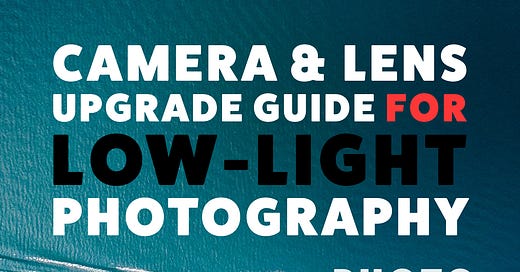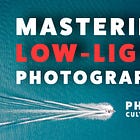Ultimate Camera & Lens Upgrade Guide for Low-Light Photography
Having the right gear is key in photography.
Whether you're a pro or just starting out, upgrading your camera and lens setup can boost your creativity.
Here are some key points to consider when looking for a camera upgrade and wide-angle lens for a mix of photo and video purposes, including low-light conditions:
Upgrade Considerations:
Problem-Solving Upgrades
Consider upgrading when new gear solves existing problems in a meaningful way, like improved performance or specific features such as a silent shutter or 4k video capability.
Financial Impact
For professionals, investing in new gear that can generate more revenue is key. Lenses like ultra-wide angles or super telephotos can open up new opportunities for work and income.
Avoid Lateral Upgrades: Upgrades that offer similar features or specifications may not be worth it. Focus on significant improvements rather than incremental changes.
Budget and Compatibility:
Budget Flexibility
With a budget of $2-3k, there is room to invest in a quality camera and lens. However, consider if a more affordable option can still meet most needs effectively.
Lens Compatibility: Look for a camera that is compatible with current lenses either natively or with an adapter to leverage existing equipment.
Camera Recommendations:
Professional Grade: For professionals looking to upgrade, investing in more professional-grade equipment that can withstand rigorous use is recommended.
Lens Investment: Prioritize investing in high-quality lenses over the camera body as lenses tend to last longer and have a significant impact on image quality.
Avoid Kit Lenses: Unless for hobbyist use, it's advised to avoid kit lenses and opt for higher-quality separate lenses for better long-term satisfaction.
Best Cameras For Low-Light Photography
Sony A7S III: Known for its exceptional low-light performance, the Sony A7S III is a top choice for low-light photography and videography. It offers remarkable sensitivity and 15+ stops of dynamic range, making it ideal for capturing clear images in challenging lighting conditions.
Canon EOS R6 Mark II: Another excellent option, the Canon EOS R6 Mark II delivers exceptional image quality, minimal noise, and stunning detail even in low-light situations. It offers high ISO performance and is well-suited for low-light photography.
Nikon Zf: The Nikon Zf is a digital camera body known for its capabilities in low-light conditions. It provides good image quality and performance, making it a reliable choice for photographers working in dimly lit environments.
Wide-Angle Lenses Recommendations for Canon EOS 60D:
Sigma 20mm f/1.4 DG HSM Art Lens:
Features a large aperture of F1.4, making it ideal for low-light conditions and indoor photography.
Designed for full-frame cameras but compatible with APS-C sensors like the Canon EOS 60D.
Suitable for landscape photography, videography, astrophotography, and event photography.
Known for its exceptional quality but comes at a higher price point.
Offers excellent performance for wide-angle shots and low-light conditions.
Considered one of the best wide-angle lenses for the Canon EOS 60D.
Canon EF-S 17-55mm f/2.8 IS USM:
A versatile zoom lens with a constant aperture of f/2.8, suitable for various shooting scenarios.
Provides image stabilization and high-quality images throughout the zoom range.
Ideal for capturing a wide range of subjects from landscapes to portraits.
Sigma 18-35mm f/1.8 DC HSM Art:
Offers a wide aperture of f/1.8 throughout the zoom range, allowing for excellent low-light performance.
Known for its sharpness and image quality, making it a popular choice among photographers.
Provides versatility for different types of photography, including landscapes and portraits.
Canon EF-S 15-85mm f/3.5-5.6 IS USM:
Offers a versatile zoom range suitable for various shooting situations.
Provides image stabilization and good image quality across different focal lengths.
Ideal for capturing landscapes, portraits, and everyday photography
Considering these points, it's important to assess specific needs, the potential for revenue generation, and the level of compatibility with existing equipment when choosing a new camera and wide-angle lens upgrade.
I hope that helps,
Hakan.




